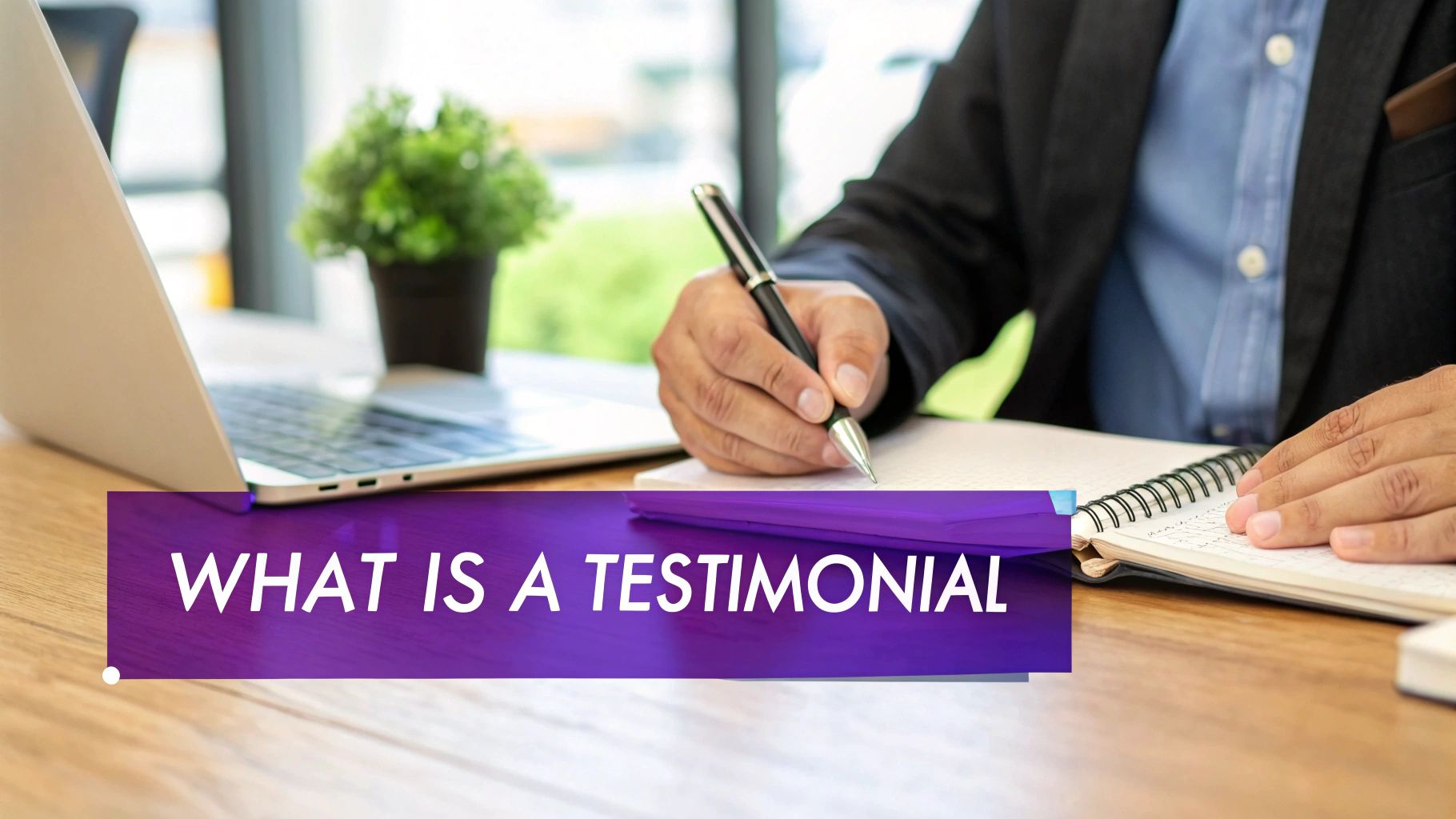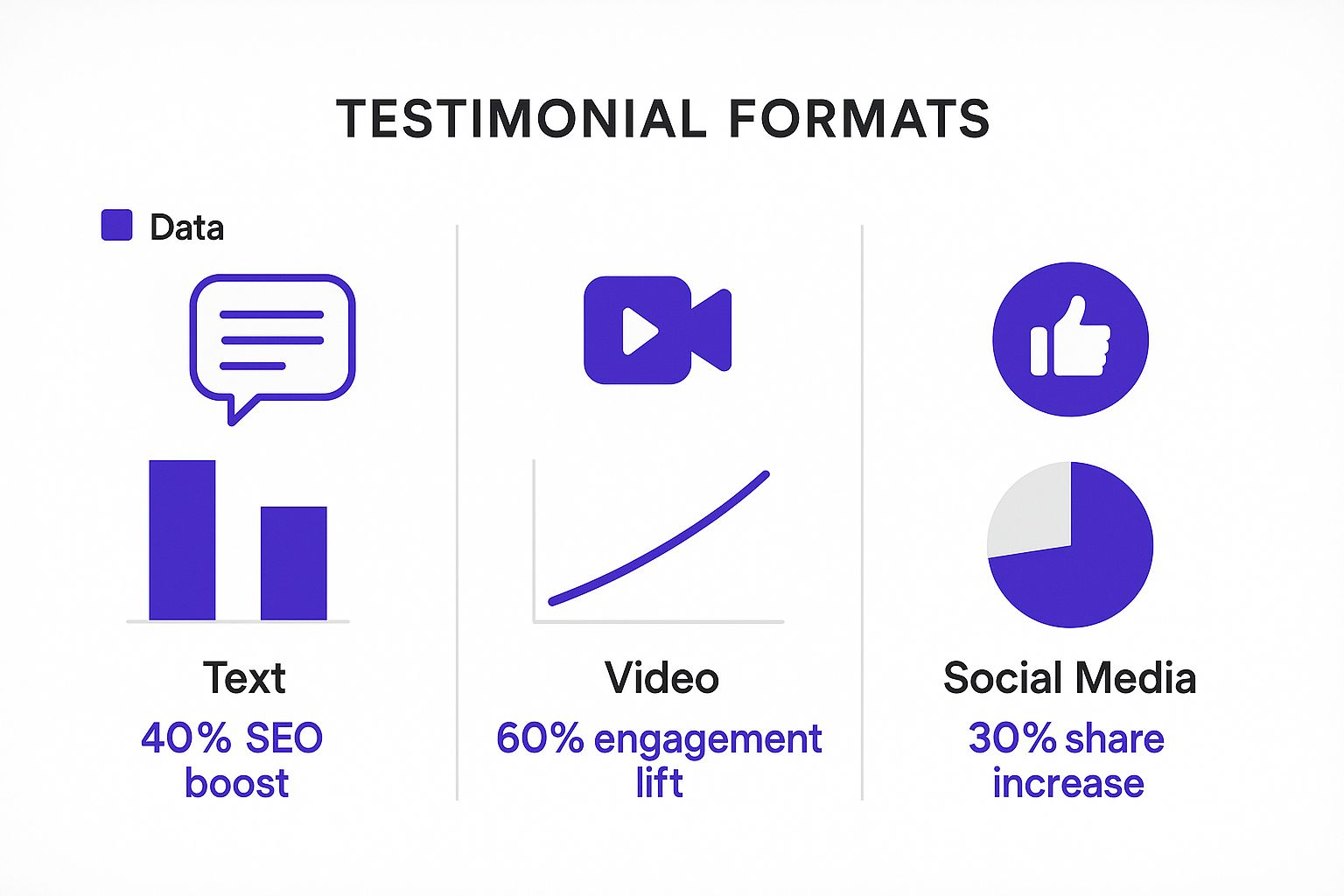How Do You Write a Testimonial That Sells
Struggling with how do you write a testimonial? Learn to craft authentic customer stories that build trust, drive conversions, and grow your business.
Posted by
So, you want to write a testimonial? The first thing to get right is that you’re not just collecting a quote. You’re telling a story—a story of transformation.
A truly great testimonial goes way beyond generic praise. It zeroes in on a specific, painful problem and positions your product as the clear, proven solution, all through the voice of a real, happy customer.
The Real Power of an Authentic Testimonial

Let's be clear: testimonials are so much more than just "social proof" to sprinkle on a landing page. They're foundational trust signals that can make or break a potential customer's decision. They work by translating your marketing claims into relatable, human experiences.
When a prospect reads a genuine story from someone who faced the exact same challenges they're dealing with, it creates an instant connection. This isn't about bragging; it's about showing real-world value from a source they can actually believe.
Build Trust and Drive Sales
The numbers don't lie. The impact of authentic customer stories on buying behavior is massive. For example, recent data shows that 72% of customers trust a business more after reading positive reviews. Even better, strategically placing these stories can boost conversions by a staggering 270%. That’s a direct line from happy customers to more revenue.
This works because it shortens the sales cycle. Prospects show up with fewer objections because someone just like them has already vetted your solution. Your marketing just got a whole lot more efficient.
A powerful testimonial doesn't just say, "This product is great." It says, "I had this specific problem, and this product provided the exact solution, leading to these amazing results."
A great testimonial has a few key ingredients that make it work. I've broken them down in this quick-reference table so you can see exactly what to aim for.
Anatomy of a High-Impact Testimonial
This table breaks down the core components of a testimonial that converts, providing a quick reference for the key elements to include.
| Component | What It Does | Why It Matters |
|---|---|---|
| Specific Problem | Describes the "before" state—the pain point the customer experienced. | Makes the story relatable to prospects facing the same issue. |
| Clear Solution | Explicitly mentions your product or service as the hero of the story. | Directly connects the positive outcome to your brand. |
| Quantifiable Result | Shows a measurable "after" state (e.g., "saved 10 hours," "increased revenue by 20%"). | Provides concrete proof of value and moves beyond vague praise. |
| Authentic Voice | Uses the customer's real, unpolished language and tone. | Builds trust and makes the story believable and human. |
| Customer Identity | Includes a name, photo, and maybe a company or role. | Adds credibility and helps prospects see themselves in the customer. |
When you get these five pieces working together, you move from a simple quote to a powerful conversion asset.
Set Your Brand Apart
In a market flooded with noise, authentic voices cut through. While your competitors are busy listing features, you can be showcasing transformation. It’s this narrative approach that makes your brand more memorable and, frankly, more human.
Of course, testimonials are just one piece of the puzzle. It’s smart to understand their place alongside other essential types of social media content to build out a well-rounded strategy. But when it comes to making your marketing more compelling, a strong testimonial is your secret weapon.
Gathering Your Raw Material for Authenticity

Before you can even think about writing a powerful testimonial, you need the right ingredients. The best stories aren't pulled from thin air; they're built from real, detailed, and genuine customer feedback. Authenticity starts right here, with this raw material.
So, where do you begin? Your first move is to figure out the core message you want to spotlight. Think about a specific pain point your product or service is especially good at solving. Was it saving a busy marketing manager a ton of time? Or maybe you helped a small business owner finally look polished and professional online.
Zeroing in on a single, powerful transformation makes the final testimonial hit so much harder.
Asking Questions That Get Real Answers
To get those rich, emotional responses—the kind that actually sell—you have to ask the right questions. Closed-ended questions that only get a "yes" or "no" are a dead end. They won't give you the story you need. Instead, you need open-ended prompts that encourage people to reflect and share the details.
I’ve found that a few key questions work wonders, whether you're sending an email survey or hopping on a quick customer call:
- Before you found us, what was your biggest challenge with [the problem your service solves]? This sets the stage and paints that crucial "before" picture.
- What was the turning point that made you decide to give our solution a shot? This gets at the why—the real motivation behind their decision.
- Can you describe the specific results you've seen since using our service? This is where you push for tangible, and ideally quantifiable, outcomes.
The goal isn't just to fish for compliments. It's to extract the story. You want to understand their journey from struggle to success, all in their own words. That's the heart of a great testimonial.
For instance, a customer might start by saying, "Your service is great!" That's nice, but it's not very useful. But after a few good prompts, they could offer something way more powerful, like: "Before using your scheduler, I was burning 10 hours a week just trying to keep our social media updated. Now, I have that time back to focus on actual strategy, and our engagement has jumped by 30%."
See the difference? That level of detail transforms a generic compliment into a mini case study. Whether you use a simple Google Form, a quick video call, or an automated email sequence, gathering these specific insights is the non-negotiable first step. It's how you craft a testimonial that truly connects with and persuades your future customers.
Crafting a Compelling Testimonial Narrative
 Let's be honest, the most powerful testimonials aren't just a glowing quote. They're a story. A good testimonial takes a potential customer on a mini-journey, showing them a real transformation that makes them feel understood.
Let's be honest, the most powerful testimonials aren't just a glowing quote. They're a story. A good testimonial takes a potential customer on a mini-journey, showing them a real transformation that makes them feel understood.
When you get a piece of customer feedback, don't just copy and paste it. Think like a storyteller. By shaping that feedback into a classic three-act structure, you can turn a simple compliment into a narrative that truly connects and convinces.
Act 1: The Before
Every good story starts with a problem. This is the "before" snapshot—the part where you paint a clear picture of the struggle, frustration, or bottleneck the customer was dealing with. This is your hook. Get it right, and your ideal prospect will immediately see themselves in the story.
A vague "we needed better marketing" just doesn't cut it. Instead, get specific: "Our team was burning 15 hours a week manually scheduling social media posts, and our engagement was completely flat." See the difference? That's a real, tangible pain point.
Act 2: The During
Next, introduce your product as the hero of the story—the turning point. This is the "during" phase, where the customer shares their experience using your solution. The key here is to keep it focused on their experience, not just a dry list of features.
Use the customer’s own words whenever you can to keep it authentic. Something like, "Once we started using the platform, the automated scheduling instantly freed up our entire content team," directly ties your solution to the problem you just established. For a deeper dive into structuring these stories, check out our complete guide on https://www.endorseflow.co/blog/how-to-write-a-testimonial.
Act 3: The After
Finally, you land the punchline: the "after." This is where you reveal the real-world, positive results. The more specific and measurable the outcome, the more believable and powerful the testimonial becomes.
The best testimonials don't just say a product is great; they prove its value with concrete evidence. This is what moves a prospect from simply being interested to actually trusting you.
A weak "after" is forgettable. A strong one sticks: "Now, we schedule a month of content in just two hours, and our audience engagement has increased by 45%." That's a clear, desirable outcome that sells itself.
This kind of storytelling is a cornerstone of effective content marketing. In fact, 72% of marketers see more lead generation when their content includes testimonials. It’s a direct line to growth. For anyone looking to get more efficient with their content, resources like these ChatGPT prompts tailored for digital marketers can be a great place to start.
A text-only testimonial is a good start, but adding a face to the words is where the real magic happens.
If you’re sticking with text, the quickest way to boost its power is to make it feel human. Always include the customer's full name, their company, and a decent, professional-looking headshot. Just like that, an anonymous quote transforms into a message from a real, verifiable person. It’s an instant credibility booster.
But if you really want to connect with potential customers, video is the way to go. Video testimonials are incredibly powerful because they deliver emotion, tone, and sincerity in a way that text just can't match. Seeing and hearing a genuinely happy customer share their story builds a level of trust that’s hard to beat.
The Unmatched Power of Video
Video isn’t just a nice-to-have anymore; it's a powerhouse for driving action. The numbers don't lie: recent studies show that 92% of larger organizations and 95% of medium-sized businesses see higher conversion rates after adding video testimonials to their marketing mix.
That’s a huge lift, and it all comes down to the raw authenticity and natural engagement of video.
This image breaks down how different formats stack up across key metrics. Pay close attention to the lift video provides.

While text is great for SEO, you can see that video delivers a massive boost in user engagement. That's what makes it such a vital tool for building a genuine connection with your audience.
Text vs Video Testimonials
To help you decide which format is right for your goals and resources, here's a quick side-by-side comparison.
| Feature | Text Testimonial | Video Testimonial |
|---|---|---|
| Credibility | Good, especially with a photo. | Excellent; conveys authentic emotion. |
| Effort to Collect | Low. Can be done via email or form. | Medium. Requires more coordination. |
| Engagement | Moderate. Easy to skim. | High. Captures attention and emotion. |
| SEO Value | High. Search engines can crawl text. | Moderate. Video needs supporting text. |
| Best For | Quick quotes, case studies, website snippets. | Landing pages, social media, ad campaigns. |
Ultimately, a mix of both is ideal, but if you're looking for maximum impact, video is the clear winner.
Getting Authentic Video on a Budget
Worried about the cost? Don't be. You don't need a Hollywood production crew to create a compelling video testimonial. In fact, some of the most genuine and trustworthy clips come straight from a customer's smartphone—they feel more personal and less like a slick, overproduced ad.
Here’s how to guide your customers to get great footage:
- Give Them Clear Prompts. Use the same story-driven questions you would for a written testimonial. Focus on the "before, during, and after" to help them structure their thoughts.
- Share Simple Tech Tips. Advise them to find a quiet spot with good lighting. Ask them to prop their phone on something steady and look right at the camera. Simple tips make a huge difference.
- Keep It Short and Sweet. Aim for a 60-90 second clip. That’s the sweet spot—long enough to tell a compelling story but short enough to hold a viewer's attention.
A simple, unpolished video from a real customer often feels more trustworthy than a high-budget, slickly produced ad. Authenticity is your most valuable asset.
To get the most out of your new video assets, think about how they fit into a broader effective video marketing strategy. Even a few basic edits—like adding captions and your company logo—can turn a simple phone recording into a professional, high-impact piece of content ready for your website and social channels.
Strategic Placement for Maximum Impact
So, you’ve captured a fantastic, authentic testimonial. Great! But even the most powerful customer story is useless if your ideal buyer never sees it.
The final piece of the puzzle is getting that testimonial in front of the right eyeballs at the right time. Think of your testimonials not as static quotes to slap on a webpage, but as versatile marketing assets you can deploy across the entire customer journey.
Before you plaster it everywhere, a little editing can go a long way. The goal here is to make it punchy and clear while keeping the customer's real voice intact. Trim any fluff, but never, ever change the core message or tone. A great testimonial should be easy to scan, delivering its impact in just a few seconds.
Where Should You Put Your Testimonials?
Where you place a testimonial is just as crucial as what it says. Different spots on your website and in your marketing serve different purposes, helping to guide a potential customer from initial curiosity to a confident purchase.
Here are a few high-impact locations I’ve seen work wonders:
- Your Homepage: This is your digital front door. Put a strong, results-focused testimonial front and center to build immediate trust with new visitors. It’s your first and best chance to show you’re the real deal.
- Product/Service Pages: This is where you get specific. Use testimonials that directly relate to that particular offering. If someone is hesitating over a feature or a price point, a relevant story can be the final nudge they need.
- The Checkout Process: Ever seen someone abandon their cart at the last second? A short, reassuring testimonial right next to the "Buy Now" button can quiet those last-minute doubts and significantly reduce cart abandonment.
- Email Campaigns: Don't let your testimonials just sit on your site. Weave them into your nurture sequences and promotional emails to sprinkle in social proof at key decision-making moments.
Remember, a single customer story can be a content goldmine. A powerful quote can go on a pricing page, the full story can live on a dedicated testimonials page, and a short video clip can become a killer social media ad.
Thinking strategically about placement transforms a simple review into an active part of your sales engine.
Of course, this all starts with getting that initial "yes" from a happy customer. If you need a little help there, our in-depth article on how to ask for testimonials will make sure you’re getting the best possible raw material to work with.
Common Questions About Writing Testimonials
Even with the perfect game plan, a few tricky questions always pop up once you get down to the nitty-gritty of crafting testimonials. Let's walk through some of the most common ones I hear and get you some clear, practical answers.
Can You Edit a Customer Testimonial?
Yes, absolutely—but you need to be careful. It’s completely fine to clean things up for clarity, brevity, or to fix a stray typo. Think of it as polishing a gem, not recutting it. Go ahead and trim that rambling video clip or correct a small grammatical error in a written quote.
What you can never do is change the customer's original meaning. The second you alter their intent, the testimonial loses its authenticity.
My go-to rule? Always send the final, edited version back to the customer for a quick thumbs-up before you publish it. It’s a simple step that protects your relationship and keeps the story genuine.
How Long Should a Testimonial Be?
Honestly, there's no magic number. The right length is all about the format and where you plan to feature it.
Here are a few guidelines I’ve found work best:
- Website Snippets: For a homepage or product page, keep it short and sweet. A punchy 2-3 sentences that zero in on a key result is perfect.
- Video Testimonials: The sweet spot is 60-90 seconds. That gives you enough time to tell a compelling "before and after" story without losing your audience's attention.
- Dedicated Case Studies: For in-depth testimonial pages, you can go longer. Just be sure to break up the text with headings, pull quotes, and images to make it easy to scan.
The most important rule is that every single word needs to earn its spot. If a sentence doesn't add real value or strengthen the customer's story, just cut it.
What If a Customer Gives Vague Feedback?
We’ve all been there. You get a review that just says, "Your service is great!" While it's nice to hear, it doesn't really help you. Think of this as a starting point, not the final product. Your job is to gently dig a little deeper.
Send a follow-up asking for specifics. Something like, "Thank you so much! We’d love to know, what specific problem did our service help you solve?" or "What kind of results have you seen since you started working with us?"
Often, customers just need a little nudge to provide the kind of powerful, detail-rich stories you're looking for. For more strategies on this, check out our full guide on how to get customer testimonials.
Ready to stop chasing down vague feedback and start collecting powerful, story-driven testimonials on autopilot? EndorseFlow gives you all the tools you need to gather authentic video and text reviews and turn them into stunning social media content. Start your 14-day risk-free trial today!